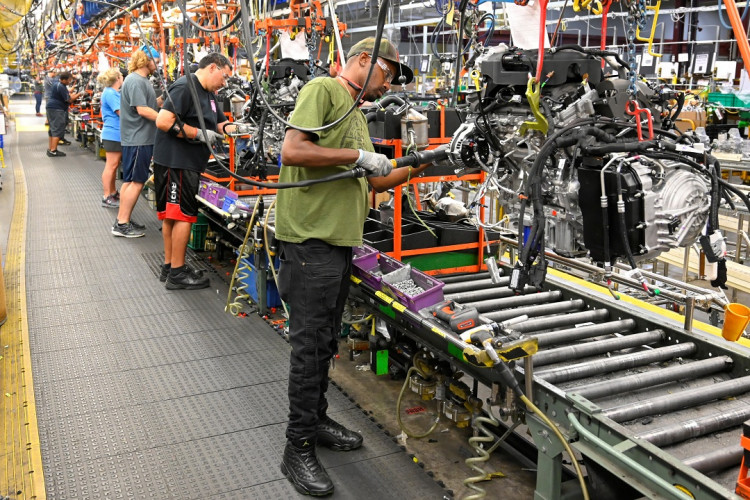In a significant move that could have wide-ranging implications for the U.S. economy, members of the United Auto Workers (UAW) union have initiated strikes at three major U.S. assembly plants belonging to General Motors, Ford Motor, and Stellantis. This decision came after the union and the automakers failed to reach an agreement on a new labor contract.
The plants in question, which are pivotal for the automakers, include GM's facility in Wentzville, Missouri, Ford's establishment in Wayne, Michigan, and Stellantis' plant in Toledo, Ohio. These facilities are responsible for producing some of the most profitable vehicles for the companies, which are still in high demand.
The UAW's decision to strike is unprecedented in its scope. For the first time in its history, the union is targeting all three of the "Big Three" automakers simultaneously. This strategy, referred to by UAW President Shawn Fain as a "stand-up strike," involves specific units going on strike, a departure from traditional methods.
The economic ramifications of this strike could be profound. A prolonged six-week strike could potentially shave off two-tenths of a percentage point from the U.S. economic growth for the quarter ending in December. This might not seem significant at first glance, but in an economy grappling with challenges like high oil prices, potential government shutdowns, and the looming end of a student loan payment moratorium, every fraction counts.
The immediate fallout will be felt by the workers themselves. The UAW represents about 146,000 workers across the three automakers. During the strike, these workers will see their incomes reduced, receiving a strike pay of $500 per week, which for many would be less than half of their regular earnings. This reduction in income will inevitably lead to decreased consumer spending, affecting businesses that rely on these workers as customers.
Beyond the direct impact on the workers, the ripple effects of the strike could be vast. Car component suppliers might face shutdowns, leading to further job losses. Consumers might see car prices spike due to reduced inventory, further exacerbating the inflationary pressures the Federal Reserve is trying to combat.
The situation is further complicated by the already strained inventory levels of the Big 3 automakers. Current holdings are just a fifth of what they were in 2019. This is a residual effect of the pandemic-era supply chain disruptions. In 2019, a 40-day strike against General Motors had a limited impact due to healthier inventory levels. However, the current scenario is starkly different. With inventory levels already at historic lows, any further disruptions could lead to significant supply shortages in the market.
Erik Gordon, a business professor at the University of Michigan, highlighted the potential fallout for suppliers of car components, such as dashboards and sound systems. Initially, these suppliers might retain their workforce, anticipating a swift resolution to the strike and a subsequent surge in activity to replenish dwindling inventories. However, as the strike drags on and component supplies back up, production slowdowns become inevitable. "Those suppliers are going to first shut down shifts and then maybe shut down manufacturing altogether," Gordon remarked.
The broader economic implications are also concerning. A report by the Anderson Economic Group estimated that a ten-day strike across all three automakers could cost the U.S. economy a staggering $5.6 billion in losses. This includes approximately $860 million in direct wages foregone by autoworkers and nearly $1 billion in missed production. The ripple effects would exacerbate these losses, with consumers and dealers bearing an additional $2 billion in costs due to delayed repairs and reduced inventory.
The state of Michigan, home to a significant portion of the U.S. auto industry, stands to be particularly hard hit. A report authored by economic forecaster Gabriel Ehrlich from the University of Michigan suggests that a four-week strike against all three automakers could result in the loss of 161,000 jobs in Michigan alone. A prolonged strike could push this number past 300,000.
For consumers, the timing couldn't be worse. With already limited choices due to low inventories, the strike could push vehicle prices even higher. "For consumers, it's a terrible time to go out and buy a car," Gordon said. "If you have to buy a car, one thing is for sure: you're not going to get any big bargains."
The situation has garnered attention at the highest levels of government. On Thursday evening, the White House confirmed that President Joe Biden had engaged in discussions with UAW President Shawn Fain and leaders of the major auto companies to assess the status of the ongoing negotiations.
As the clock ticks and the standoff continues, the stakes for both the workers and the broader U.S. economy keep rising. The coming days will be crucial in determining the trajectory of this high-stakes labor dispute.






